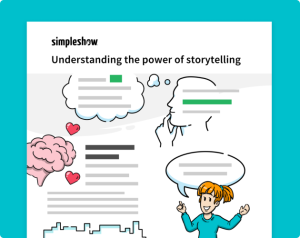The 7 most common storytelling mistakes and how to avoid them
Written by Maren Dinges | 12th April 2024

Many companies incorporate their brand messages into stories, highlighting the added value of their product or service. However, storytelling requires a particular skill set, and there are differences between merely telling a story and conveying a message effectively. To ensure that your storytelling effectively supports your brand, it is important to avoid the following seven common mistakes.
Don’t feel like reading? Watch this video:

1. You have no identifiable message
What is the story trying to tell me? If that’s the question your audience is asking, you’ve already lost. Stories can be beautifully written – if they lack brand relevance, they have missed the mark.
Every great story has a central message that connects with your intended audience. This is what makes your story and your brand memorable. To enhance your writing skills, it is important to follow the “rule of one”: Every story should have only one main point that it revolves around.

2. You only focus on yourself
Information does not create emotion. The same goes for your brand’s messaging. If your stories are all about your company and its benefits, you’ll not only bore your audience, you’ll make your brand seem inauthentic.
Effective storytelling requires you to emphasize the value of your brand rather than just providing information about your company. Instead of telling a story about the features of your fitness band, tell a story about how the band helps you stay motivated during your workout and track your progress.
This simple change puts your audience and their needs at the center of your communication.

3. Your plot is predictable
The “wow” factor is a crucial element in storytelling, whether it’s in a movie or a book. A plot twist that completely alters the course of the story can be captivating and ensure the audience’s undivided attention.
However, if your story is predictable, people’s focus tends to drift, and the memory of it fades quickly. Even if they have consumed the story, they will likely forget it soon after.
In brand communication, making giant leaps is unnecessary to keep the audience engaged. Small moments of excitement and fresh elements can be enough to keep them interested. So, when crafting a story, aim to create a buzz by introducing unexpected twists and turns. This way, you’ll know you’ve captured their attention.

4. Your story lacks character development
Every story has a hero, and what makes the character a hero is gradually revealed as the story unfolds. This is what keeps the suspense going and engages the audience. If you create characters that don’t evolve, you deprive the audience of participating in the character’s journey, and you also miss the opportunity to convey a message through the character’s actions.
For instance, “from rags to riches” describes a journey from being a dishwasher to becoming a millionaire. If you introduce the character as a millionaire from the outset, the story’s learning effect is lost, and the inspirational aspect of the story is also diminished.

5. You use passive language
Storytellers deliberately use active language because it brings messages to life. Active language helps to formulate statements directly, ensuring greater clarity in the narrative thread. It also gives more momentum to the action, allowing people to become more involved in the story instead of just being told a complete narrative.
In short, using active constructions in storytelling makes the story more concise and increases the audience’s emotional connection to the content. Using adjectives and deliberately placed verbs can evoke feelings of love, affection, excitement, empathy, or understanding in your target audience, depending on the message you want to convey.
By using active language and evoking emotions in your storytelling, you achieve what storytelling is all about: your target audience identifies with your content and bonds with your brand.

6. You ignore feedback
Great stories take time to develop; only the best are worth sharing. Before presenting your story to a large audience, it is a good idea to test it in front of a rehearsal audience. Their reactions will provide valuable feedback to help you improve your storytelling skills and narrative structure.
It’s important to note that an actual room full of people is not necessary. You can get similar results by soliciting feedback from your team, going through editorial rounds, or conducting polls. Paying attention to reactions and adjusting your story accordingly will help you become a better storyteller with each iteration.

7. You omit the Visual Dimension
Those who overlook the visual aspect of storytelling miss a great opportunity. The visual dimension complements the words you use and provides a clear context, leaving no room for ambiguity or misinterpretation by the audience. This gives you complete control over how you want to present your brand.
Therefore, it is highly recommended that you incorporate images to tell your stories, preferably dynamically and engagingly. Video allows you to create a consistent narrative for each story and fully immerse your target audience in your brand identity. The use of imagery helps create a lasting impression and keeps your brand top of mind, making them more likely to choose you when they want to buy fitness bands.
Avoid storytelling mistakes with simpleshow video maker:
Making mistakes in storytelling is easy, and writing a good story takes a lot of practice. Luckily, the advancement of artificial intelligence can now assist you in improving your storytelling skills. With the simpleshow video maker, you can avoid all the common mistakes without learning the art of storytelling yourself.
Added value through information
You provide the input and the simpleshow video maker turns it into added value. You can even decide how the information is presented. Whether your story is formal, neutral, or humorous, and whether it has a main character or not, is entirely up to you.
The Explainer Engine then transforms your information into narrative messages, and the Simplifier can even turn presentations, meeting notes, or long documents into a compelling story.
Effective design elements
Storytelling mistakes usually result in stories being forgotten or not being associated with your brand at all. You can avoid this by adding a visual layer to your stories.
simpleshow video maker designs your stories in your corporate colors and style. This allows you to check off the storytelling mistakes that break the brand context. Now, illustrate your story in a way that supports the narrative thread and develops the exact story that will appeal to your target audience.
Storytelling is a craft
Storytelling mistakes can weaken your content and lead to unintended consequences. If your narrative structure is inconsistent, it can cause confusion and misinterpretations.
Using clichés can bore your audience, and overlooking brand messages can cause your communication to miss the mark. To overcome these challenges, you can use simpleshow video maker. With this tool, you can take control of your storytelling without spending years learning the craft. By using simpleshow, you can avoid all these mistakes and ensure a high-quality presentation.

Are you ready to transform your communication strategy with the power of videos?
Join our webinar Reimagine your communication strategy: Unlock the power of video and learn how some of our customers improved their communication strategy with video. Get inspired by real-life examples and discover how you can improve your own communications.
Date: April 25, 2024 Time: 12 PM ET
Secure your spot today and take the first step towards mastering your communication strategy with video.
Frequently Asked Questions
What’s the #1 storytelling mistake brands make?
A story without a single, clear message. Use the “rule of one”. That is to build the narrative around one main point that’s relevant to your audience, or the story will feel unfocused and forgettable.
How do I stop telling a story that’s just about us?
Shift from features to audience outcomes. Frame benefits in the context of how people succeed or feel with your product (e.g., motivation and progress with a fitness band), not just what the product does.
How can I keep my brand story from being predictable?
You don’t need wild plot twists! Small surprises and fresh elements sustain attention and memory better than a flat, expected arc.
Why does character development matter in brand content?
Characters who evolve invite the audience into a journey (learning, struggle, progress). If the “hero” starts fully formed, you lose suspense, insight, and inspiration.
What visuals should I use? And, can the built-in features in simpleshow video maker help me avoid these mistakes?
Yes. Choose simple, relevant visuals that reinforce one clear message. The built-in features in simpleshow video maker help you get there fast: the Story Generator drafts a focused script, the Simplifier turns long docs into concise scenes, the Explainer Engine picks fitting illustrations/animations, the Timing Engine syncs visuals to your voice, and the Brand Kit keeps everything on-brand. Together, they reduce clutter, prevent “all about us” messaging, and keep your story surprising yet clear.

